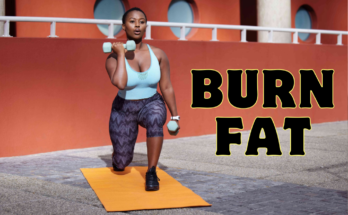Hello, Beautiful People! Want to have a strong back to look impressive? Let’s get into best back exercise with dumbbell. This will play a vital role in your fitness and posture.
Imagine feeling confident because your back muscles are well-developed and tough. Whether you’re a starter or an expert fitness expert, these moves will energize you. Say goodbye to boring routines and hello to an exciting way to build strength.
Let’s improve your physique!
Benefits of Back Exercise

Benefits of Back Exercise | Description |
|---|---|
| Upgrade Posture | Builds up muscles that support our spine. This make better posture and less slouching. |
| Injury Prevention | Increases the stability of the back. It reduces the risk of injuries. |
| Enhanced Performance | Speeds up performance in different physical activities. It provides a supportive base. |
| Increased Strength | Raise muscle mass in the back. It takes part in upper body power. |
| Better Balance | It makes better balance and coordination. It involves stabilizing the muscles. |
| Functional Fitness | Increases the ability to perform daily activities easily. For example, lifting objects. |
| Aesthetic Appeal | Takes part in an obvious muscular physique. |
| Reduced Back Pain | Supports the lower back. It helps relieve chronic back pain issues. |
| Boosted Metabolism | Increased muscle mass can cause a higher resting metabolic rate. It helps in weight management. |
| Mental Well-being | Physical exercise releases endorphins that makes better mood and reduce tension. |
Choosing the Right Dumbbells
Selecting the right dumbbells is necessary for boosting up the productiveness of your back exercises. It makes sure safety. Following are some tips to help you choose the suitable dumbbells for your fitness goals:
Weight Selection
- If you’re a starter, begin with lighter weights and gradually move towards heavier weights.
- Choose a weight that allows you to perform the exercise with proper form for the desired number of repeating. Slowly, increase the weight as your strength gets better.
- When selecting a weight, make sure you can complete 10-12 repetitions with good form.
Types of Dumbbells for Back Exercise
- Fixed Dumbbells: These come in a fix weight. They are perfect for home gyms. They are easy to use and carry.
- Versatile Dumbbells: These allow you to change the weight by adding or removing plates. It making them flexile. They produce good results but might require more time to modify during workouts.
- Hex Dumbbells: These have a hexagonal shape. They spin them away from rolling. They are tolerable for different exercises. They provide rubber-coating to preserve floors.
- Vinyl or Neoprene-Coated Dumbbells: These are comfortable to grasp and best for lighter weights. It makes them great for beginners.
Additional Tips
- Make sure the dumbbells have a comfortable grip that doesn’t slide during exercises. I personally use rubber handles. They provide extra comfort.
- Space Consideration: If you have less space, you can use adjustable dumbbells. They are a better choice as they take up less area.
- Budget: Fixed dumbbells can be more costly. While, adjustable dumbbells offer a systematic solution.
By choosing the right dumbbells, you can increase your workout experience. You can make sure safety, and focus on your back muscles.
The following video is about back exercises with dumbell:
Warm-Up Routine
Warming up before any workout is necessary to prepare muscles. It increases heart rate, and lessens the risk of injury. Following is an effective warm-up routine to get your back muscles prepared for a thrilling dumbbell workout:
Importance of Warming Up
- Increased Blood Flow
- Improved Flexibility
- Mental Preparation
Sample Warm-Up Exercises
1. Arm Circles
Stand with feet shoulder-width away from each other. Expand your arms out to the sides at shoulder height. Make small circles with your arms. After that, gradually increase the size of the circles. Remain 30 seconds in each direction. It relax shoulders and upper back muscles.
2. Cat-Cow Stretch
Get on your hands and knees in a tabletop site. Make your back curve towards the ceiling, then let of your belly towards the floor while lifting your head and tailbone. Repeat this for 10-15 cycles. It increases flexibility in the spine.
3. Torso Twists
Stand with feet shoulder-width apart and knees little twisted. Hold your arms out and wrap your torso to the right, then to the left. Do this for 1 minute. It takes part in warming up the lower back muscles.
4. Bent Over T-Spine Rotation
Stand with feet hip-width at a distance. Then, bend at the hips with a little curve in the knees. Place one hand on the floor and revolve your upper body. The other hand should reach towards the roof. Perform 10 rotations per side. It moves the thoracic spine and upper back.
5. Dynamic Lat Stretch
Stand with feet shoulder-width at distance. Expand one arm above your head and bend to the opposite side, stretching the side of your body. Do this for 1 minute. It warms up the latissimus dorsi and oblique muscles.
6. Shoulder Shrugs
Stand with feet shoulder-width at distance. Place above your shoulders towards your ears and then lower them down again. Do this for 15-20 times. It warms up the trapezius and shoulder muscles.
1. Dumbbell Deadlift
In this, you have to stand with feet hip-width at a distance. Hold a dumbbell in each hand. With a little curve in your knees, hinge at your hips to lower the dumbbells towards the floor. During this, keep your back straight. Involve your glutes and hamstrings to come back to standing. The targeted muscles are:
- Lower back
- Glutes
- Hamstrings.
2. Bent Over Row
In this, hold a dumbbell in each hand, curve at your hips and knees and keep your back straight. Pull the dumbbells towards your waist, compressing your shoulder blades together. Lower the dumbbells again to the starting position. The targeted muscles are:
- Upper back
- Middle back
- Biceps.
3. Single-Arm Dumbbell Row
In this, position one knee and hand on a bench for support. With the opposite hand, hold a dumbbell and let it be suspended straight down. Pull the dumbbell towards your hip, compressing your back muscles. Lower it back down and repeat. The targeted muscles are:
- Upper back
- Middle back
- Biceps.
4. Dumbbell Shrug
In this exercise, you have to stand with feet shoulder-width at a distance. Carry a dumbbell in each hand. Raise your shoulders towards your ears, compressing your trapezius muscles. Lower your shoulders back down. It focuses on following muscles:
- Trapezius
- Upper back.
5. Dumbbell Pullover
Lie on a bench with your feet uniform on the floor. Carry a dumbbell in both hands. And extend your arms higher than your chest. Lower the dumbbell at the back of your head in an arc motion. After that, bring it back to the starting point. It focuses on following muscles:
- Lats
- Chest
Criceps.
6. Renegade Row
Begin in a plank position with a dumbbell in each hand. Keep your body stable. Now, raise one dumbbell towards your waist. Bring it back down and do again on the other side. Focused muscles are:
- Upper back
- Core
- Shoulders.
I’ve been incorporating Chest supported Dumbell Rows into my Pull sessions recently.
Elite exercise for training Back, it’s one of those exercises you can’t cheat on the reps, you have to do them correctly with the right weight.
Send me a DM and I’ll send over today’s session. pic.twitter.com/K49w4nZpdJ
— Thomas Foster (@TAG_Foster) October 21, 2023
Thrilling Back Exercise with Dumbbells
Including Back Exercise into Your Routine
Including back exercises into your workout routine makes sure balanced strength development. It also stops muscle imbalances. Following is the routine how you can include these exercises into your fitness routine:
Creating a Balanced Workout Plan
- Include back exercises as part of a full-body workout routine. This will make sure balanced muscle development.
- Select particular days for upper body, lower body, and core workouts.
- Try to work on your back muscles at least twice a week for best outcomes.
Sample Weekly Routine for Back Exercise
Day 1: Upper Body
- Dumbbell Deadlift: 3 rounds of 12 reps
- Bent Over Row: 3 rounds of 10 reps
- Dumbbell Shrug: 3 rounds of 15 reps
Day 3: Full Body
- Single-Arm Dumbbell Row: 3 rounds of 12 reps per arm
- Dumbbell Pullover: 3 rounds of 10 reps
- Renegade Row: 3 rounds of 8 reps per side
Day 5: Upper Body
- Dumbbell Deadlift: 3 rounds of 12 reps
- Bent Over Row: 3 rounds of 10 reps
- Dumbbell Shrug: 3 rounds of 15 reps.
Cool Down and Stretching
Cooling down after your workout is necessary for helping recovery. It reduces muscle discomfort, and makes better flexibility. Following is an efficient cool-down routine:
Importance of Cooling Down
- Slow Heart Rate Reduction
- Muscle Recovery
- Flexibility Improvement
Sample Cool-Down Routine
Light Cardio: Do 5-10 minutes of light cardio. It helps in changing your body from extreme exercise to a resting state.
Cat-Cow Stretch: Do this for 1-2 minutes. It stretches the spine and release back tension.
Child’s Pose: Do this pose for 1-2 minutes. It stretches the lower back and shoulders.
Thread the Needle: Do this for 30 seconds on each side. It stretches the upper back and shoulder.
Conclusion
In conclusion, including these thrilling back exercises with dumbbells into your routine can modify your fitness journey. It builds strength, makes posture better, and boosts performance.
By choosing the right weights, you’ll achieve splendid results. Remember to cool down and stretch to improve flexibility. With continuous effort, you’ll not only enjoy the process but also see strength in your back. Accept the challenge and celebrate the progress as you build a stronger, healthier back!
Let me know which exercise did you find the best?
FAQ
1. How many times should I do back exercises with dumbbells?
You should try to work on your back muscles 2-3 times a week. This allows for muscle recovery with strength. Make sure at least 48 hours of rest between your workouts.
2. What should be the weight of dumbbells in the beginning?
If you’re a beginner, start with lighter weights. Gradually increase the weight. This will challenge your muscles and promote growth.
3. Can I perform these exercises at home?
Yes, these dumbbell exercises can be performed at home. You should have dumbbells and enough space. For some exercises, a bench may be helpful.
4. What can I do when I feel pain during these exercises?
Stop the exercise at the moment if you experience severe pain. Talk to a fitness professional. Make sure you are performing exercises correctly.
5. How much time will it take to see outcomes?
Results are different on the basis of:
- Individual fitness levels
- Consistency
- Effort.
Normally, you can see betterment in strength muscles within 4-6 weeks of regular training.




